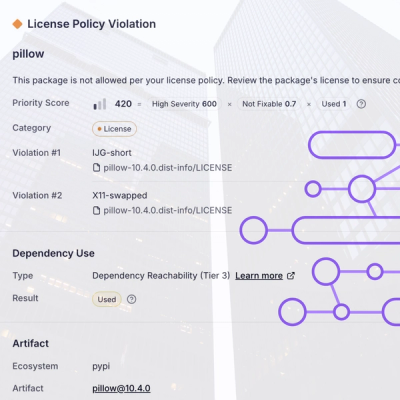
Research
/Security News
Critical Vulnerability in NestJS Devtools: Localhost RCE via Sandbox Escape
A flawed sandbox in @nestjs/devtools-integration lets attackers run code on your machine via CSRF, leading to full Remote Code Execution (RCE).
whatsapp-chatbot-python
Advanced tools
This library helps you easily create a Python chatbot with WhatsApp API.




whatsapp-chatbot-python is a library for integration with WhatsApp messenger using the API service green-api.com. You should get a registration token and an account ID in your personal cabinet to use the library. There is a free developer account tariff.
The documentation for the REST API can be found at the link. The library is a wrapper for the REST API, so the documentation at the link above also applies.
To send a message or perform other Green API methods, the WhatsApp account in the phone app must be authorized. To authorize the account, go to your cabinet and scan the QR code using the WhatsApp app.
Installation:
python -m pip install whatsapp-chatbot-python
from whatsapp_chatbot_python import GreenAPIBot, Notification
Before launching the bot, you should remove Webhook Url (if set) from Personal Cabinet or by setting empty webhookUrl by using SetSettings method. These settings will be enabled by bot automatically:
{
"incomingWebhook": "yes",
"outgoingMessageWebhook": "yes",
"outgoingAPIMessageWebhook": "yes"
}
bot = GreenAPIBot(
"1101000001", "d75b3a66374942c5b3c019c698abc2067e151558acbd412345"
)
bot = GreenAPIBot(
"1101000001", "d75b3a66374942c5b3c019c698abc2067e151558acbd412345",
bot_debug_mode=True
)
You can also enable API debug mode:
bot = GreenAPIBot(
"1101000001", "d75b3a66374942c5b3c019c698abc2067e151558acbd412345",
debug_mode=True, bot_debug_mode=True
)
To start receiving incoming notifications, you need to set up an instance. Open the personal cabinet page at the link. Select an instance from the list and click on it. Click Change. In the Notifications category, enable all notifications that you want to receive.
To start receiving messages, you must create a handler function with one parameter (notification). The notification
parameter is the class where the notification object (event) and the functions to answer the message are stored. To
send a text message in response to a notification, you need to call the notification.answer function and pass there
the text of the message. You don't need to pass the chatId parameter because it is automatically taken from the
notification.
Next, you need to add the handler function to the list of handlers. This can be done with the bot.router.message
decorator as in the example or with the bot.router.message.add_handler function. The decorator must be called with
brackets.
To start the bot, call the bot.run_forever function. You can stop the bot with the key combination Ctrl + C.
In this example, the bot will only answer the message message.
Link to example: base.py.
@bot.router.message(text_message="message")
def message_handler(notification: Notification) -> None:
notification.answer("Hello")
bot.run_forever()
You can receive not only incoming messages but also outgoing messages. You can also get the status of the sent message.
bot.router.outgoing_message object;bot.router.outgoing_api_message object;bot.router.outgoing_message_status object.The body of the notification is in notification.event. In this example, we get the message type from the notification
body.
In this example, the bot receives all incoming messages.
Link to example: event.py.
@bot.router.message()
def message_handler(notification: Notification) -> None:
print(notification.event)
bot.run_forever()
Messages can be filtered by chat, sender, message type, and text. To filter chat, sender, and message type, you can use
a string (str) or a list of strings (list[str]). The message text can be filtered by text, command, and regular
expressions. Below is a table with filter names and possible values.
| Filter name | Description | Possible values |
|---|---|---|
from_chat | Chats or chats from which you want to receive messages | "11001234567@c.us" or ["11001234567@c.us", "11002345678@c.us"] |
from_sender | The sender or senders from whom you want to receive messages | "11001234567@c.us" or ["11001234567@c.us", "11002345678@c.us"] |
type_message | The type or types of message to be handled | "textMessage" or ["textMessage", "extendedTextMessage"] |
text_message | Your function will be executed if the text fully matches the text | "message" or ["message", "MESSAGE"] |
regexp | Your function will be executed if the text matches the regular expression pattern | r"message" or (r"message", re.IGNORECASE) |
command | Your function will be executed if the prefix and the command match your values completely | "help" or ("help", "!/") |
@bot.router.message(command="command")
bot.router.message.add_handler(handler, command="command")
To filter messages by chat, sender, or message type, you must add a string (str) or a list of strings (list[str]).
from_chat = "11001234567@c.us"
from_sender = "11001234567@c.us"
type_message = ["textMessage", "extendedTextMessage"]
You must add a string (str) to filter messages by text or regular expressions.
text_message = "Hello. I need help."
regexp = r"Hello. I need help."
Add a string (str) or a tuple (tuple) to filter messages by command. You need to specify either a command name or a
command name and a prefix string. The default prefix is /.
command = "help"
command = ("help", "!/")
In this example, the bot will send a photo in response to the rates command.
Link to example: filters.py.
@bot.router.message(command="rates")
def message_handler(notification: Notification) -> None:
notification.answer_with_file(file="data/rates.png")
bot.run_forever()
The method is temporarily not working. When the method is called, a 403 error will be returned.
To be notified when a button is pressed, you must use the bot.router.buttons object.
Link to example: buttons.py.
@bot.router.buttons()
def buttons_handler(notification: Notification) -> None:
notification.answer_buttons("Choose a color", [
{
"buttonId": 1,
"buttonText": "Red"
},
{
"buttonId": 2,
"buttonText": "Green"
},
{
"buttonId": 3,
"buttonText": "Blue"
}
])
bot.run_forever()
As an example, a bot was created for user registration.
To manage user states, we need to create states. Import the BaseStates class and inherit from it. To manage the state
we need to use notification.state_manager. The manager has methods for getting, setting, updating and deleting state.
You also have the option to save the user's data in his state.
| Manager's method | Description |
|---|---|
get_state | Returns a state class with state name and user data |
set_state | Sets the state for the user. If the state exists then the data will be deleted |
update_state | If a state exists, it changes it. If not, it creates a new state |
delete_state | Deletes the user's state. Remember to get the data before deleting |
get_state_data | If the state exists, it returns the data in the form of a dictionary (dict) |
set_state_data | If the state exists, it changes the data to the new data |
update_state_data | If the state exists, it updates the data. If no data exists, the data will be created |
delete_state_data | If the state exists, it deletes the data |
The first argument is the sender ID. It can be found by calling notification.sender.
Link to example: states.py.
from whatsapp_chatbot_python import BaseStates, GreenAPIBot, Notification
bot = GreenAPIBot(
"1101000001", "d75b3a66374942c5b3c019c698abc2067e151558acbd412345"
)
class States(BaseStates):
USERNAME = "username"
PASSWORD = "password"
@bot.router.message(state=None)
def message_handler(notification: Notification) -> None:
sender = notification.sender
notification.state_manager.set_state(sender, States.USERNAME.value)
notification.answer("Hello. Tell me your username.")
@bot.router.message(command="cancel")
def cancel_handler(notification: Notification) -> None:
sender = notification.sender
state = notification.state_manager.get_state(sender)
if not state:
return None
else:
notification.state_manager.delete_state(sender)
notification.answer("Bye")
@bot.router.message(state=States.USERNAME.value)
def username_handler(notification: Notification) -> None:
sender = notification.sender
username = notification.message_text
if not 5 <= len(username) <= 20:
notification.answer("Invalid username.")
else:
notification.state_manager.update_state(sender, States.PASSWORD.value)
notification.state_manager.set_state_data(
sender, {"username": username}
)
notification.answer("Tell me your password.")
@bot.router.message(state=States.PASSWORD.value)
def password_handler(notification: Notification) -> None:
sender = notification.sender
password = notification.message_text
if not 8 <= len(password) <= 20:
notification.answer("Invalid password.")
else:
data = notification.state_manager.get_state_data(sender)
username = data["username"]
notification.answer(
(
"Successful account creation.\n\n"
f"Your username: {username}.\n"
f"Your password: {password}."
)
)
notification.state_manager.delete_state(sender)
bot.run_forever()
bot.api.account.getSettings()
Or
notification.api.account.getSettings()
bot = GreenAPIBot(
"1101000001", "d75b3a66374942c5b3c019c698abc2067e151558acbd412345",
raise_errors=False
)
You need to import the required constants first:
from whatsapp_chatbot_python.filters import TEXT_TYPES
Then add this filter: type_message=TEXT_TYPES.
This data is in the notification object (notification):
@bot.router.message()
def message_handler(notification: Notification) -> None:
print(notification.sender)
print(notification.message_text)
As an example, a bot was created to support the GREEN API. Command list:
To send a text message, you have to use the notification.answer method.
To send a location, you have to use the sending.sendLocation method from notification.api.
To send a message with a file, you have to use the notification.answer_with_file method.
In this example, the bot only responds to commands from the list above.
Link to example: full.py.
from whatsapp_chatbot_python import GreenAPIBot, Notification
bot = GreenAPIBot(
"1101000001", "d75b3a66374942c5b3c019c698abc2067e151558acbd412345"
)
@bot.router.message(command="start")
def message_handler(notification: Notification) -> None:
sender_data = notification.event["senderData"]
sender_name = sender_data["senderName"]
notification.answer(
(
f"Hello, {sender_name}. Here's what I can do:\n\n"
"1. Report a problem\n"
"2. Show office address\n"
"3. Show available rates\n"
"4. Call a support operator\n\n"
"Choose a number and send to me."
)
)
@bot.router.message(text_message=["1", "Report a problem"])
def report_problem_handler(notification: Notification) -> None:
notification.answer(
"https://github.com/green-api/issues/issues/new", link_preview=False
)
@bot.router.message(text_message=["2", "Show office address"])
def show_office_address_handler(notification: Notification) -> None:
chat = notification.chat
notification.api.sending.sendLocation(
chatId=chat, latitude=55.7522200, longitude=37.6155600
)
@bot.router.message(text_message=["3", "Show available rates"])
def show_available_rates_handler(notification: Notification) -> None:
notification.answer_with_file("data/rates.png")
@bot.router.message(text_message=["4", "Call a support operator"])
def call_support_operator_handler(notification: Notification) -> None:
notification.answer("Good. A tech support operator will contact you soon.")
bot.run_forever()
Licensed under Creative Commons Attribution-NoDerivatives 4.0 International (CC BY-ND 4.0) terms. Please see file LICENSE.
FAQs
This library helps you easily create a Python chatbot with WhatsApp API.
We found that whatsapp-chatbot-python demonstrated a healthy version release cadence and project activity because the last version was released less than a year ago. It has 2 open source maintainers collaborating on the project.
Did you know?

Socket for GitHub automatically highlights issues in each pull request and monitors the health of all your open source dependencies. Discover the contents of your packages and block harmful activity before you install or update your dependencies.

Research
/Security News
A flawed sandbox in @nestjs/devtools-integration lets attackers run code on your machine via CSRF, leading to full Remote Code Execution (RCE).

Product
Customize license detection with Socket’s new license overlays: gain control, reduce noise, and handle edge cases with precision.

Product
Socket now supports Rust and Cargo, offering package search for all users and experimental SBOM generation for enterprise projects.